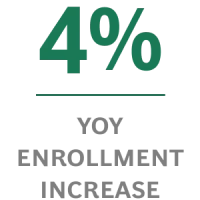The Obstacle
Despite efforts to improve access to education in India, national data from the past decade has revealed significant problems: In 2017, nearly three-quarters of 10-year-olds in the country could not perform division, and nearly 30% of 10- to 14-year-olds were reading below their age level.1 Furthermore, many school systems in India follow a standardized curriculum that lacks both flexibility and courses for areas of special focus. Add to that high dropout rates and the challenge is clear: there’s an overwhelming need to improve education in India.

To address the crucial issues affecting the school system in India, the National Institution for Transforming India (NITI) Aayog launched a bold and ambitious program, Sustainable Action for Transforming Human capital-Education (SATH-E), in Madhya Pradesh and two other states. Building on thorough diagnostics and data, SATH-E offered solutions to improve access to quality education in India. Among the goals of the program was to ensure that children from all backgrounds in Madhya Pradesh had access to at least one high-quality K–12 school within 15 kilometers of their homes.
Our Approach
In 2017, the state of Madhya Pradesh had 114,000 public schools serving nearly 10 million children. Together with NITI Aayog, the state government, and the Piramal Foundation for Education Leadership (PFEL), BCG launched a series of systemic reforms in the region, including:
- A three-month analysis of the education system in Madhya Pradesh that examined access, equity, learning, and governance outcomes
- A two-year roadmap outlining a number of structural, academic, and tracking initiatives that could help improve the quality of education, including the following:
- School mergers and consolidations to build larger, integrated K–12 schools that also helped increase the availability of teachers and principals in the state
- Academic intervention programs focused on foundational literacy and digital learning, especially amid COVID-19-related school closures
- Real-time, data-based school system monitoring to ensure leadership accountability and encourage better testing and learning assessments
Launching CM RISE to Improve Education in India
After the SATH-E program ended in 2020, BCG continued its partnership with the state of Madhya Pradesh to launch the CM RISE (Respect, Integrity, Strength, and Excellence) initiative. CM RISE has identified 9,200 schools in Madhya Pradesh that could be transformed into best-in-class models in the state over the next decade through
infrastructure upgrades, staffing and training, academic and administrative procedures, and other processes that could boost access to quality education in India.
How CM RISE Schools Help Improve Education in India
Staffing and Training: BCG helped implement robust staff selection processes and requirements to ensure that each school has a sufficient number of teachers and administrative staff. The program has also begun monitoring the number of full-time teachers in the state to better understand staffing gaps and be able to improve student-teacher ratios. Lastly, the program has prioritized the leadership development of all CM RISE school leaders through dedicated development workshops and and other activities.
Academic and Administrative Procedures: The program is tackling education problems in India by defining new processes for school leaders and teachers. CM RISE plans to implement academic reforms to improve digital and financial literacy, testing support, and career guidance. It’s also working to improve administrative procedures across the state by defining central organizing committees that design and monitor the schools’ operations and systems.
The Results
Transforming India’s education system requires a long-term agenda, but through the broader SATH-E efforts, Madyha Pradesh has made significant progress. For example, in fifth-grade math, the Indian state has jumped from ranking 24th in 2017 to third in 2021. Together with BCG, the state has also embarked on an ambitious journey of merging more than 35,000 schools into just over 16,000 campuses, which has helped improve academic quality through administrative and economic efficiencies and led to several benefits, including:
- Greater availability of teachers, principals, and administrative staff
- Increased availability of resources that created better campus environments
- Improved governance and monitoring systems that helped boost academic performance
Furthermore, within the first year of its launch, the CM RISE program helped drive access to quality education in Madyha Pradesh across several of the following key parameters:




Success of the SATHE-E and CM RISE programs has hinged on a holistic view and understanding of the root causes that have contributed to education problems in India. BCG and the government of Madhya Pradesh have leveraged that awareness to help strengthen thousands of schools, thereby providing a demonstrable model to improve the entire school system in India. Together, both groups will continue working to develop enhanced school processes and build a more robust curriculum that will continue to help pave the way for improved access to education in India.
Source
1. 2017 Annual Status of Education Report
Learn More About Improving Access to Education in India
Meet our Education Expert
Explore Our Related Insights






